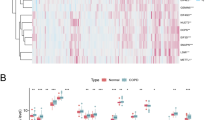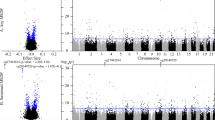Abstract
Background
Chronic lung disease (CLD) is the most common pulmonary morbidity in extremely preterm infants. It is unclear to what extent prenatal exposures influence the risk of CLD. Epigenetic variation in placenta DNA methylation may be associated with differential risk of CLD, and these associations may be dependent upon sex.
Methods
Data were obtained from a multi-center cohort of infants born extremely preterm (<28 weeks’ gestation) and an epigenome-wide approach was used to identify associations between placental DNA methylation and CLD (n = 423). Associations were evaluated using robust linear regression adjusting for covariates, with a false discovery rate of 0.05. Analyses stratified by sex were used to assess differences in methylation-CLD associations.
Results
CLD was associated with differential methylation at 49 CpG sites representing 46 genes in the placenta. CLD was associated with differential methylation of probes within genes related to pathways involved in fetal lung development, such as p53 signaling and myo-inositol biosynthesis. Associations between CpG methylation and CLD differed by sex.
Conclusions
Differential placental methylation within genes with key roles in fetal lung development may reflect complex cell signaling between the placenta and fetus which mediate CLD risk. These pathways appear to be distinct based on fetal sex.
Impact
-
In extremely preterm infants, differential methylation of CpG sites within placental genes involved in pathways related to cell signaling, oxidative stress, and trophoblast invasion is associated with chronic lung disease of prematurity.
-
DNA methylation patterns associated with chronic lung disease were distinctly based on fetal sex, suggesting a potential mechanism underlying dimorphic phenotypes.
-
Mechanisms related to fetal hypoxia and placental myo-inositol signaling may play a role in fetal lung programming and the developmental origins of chronic lung disease.
-
Continued research of the relationship between the placental epigenome and chronic lung disease could inform efforts to ameliorate or prevent this condition.
Similar content being viewed by others
Log in or create a free account to read this content
Gain free access to this article, as well as selected content from this journal and more on nature.com
or
References
Laughon, M. M. et al. Prediction of bronchopulmonary dysplasia by postnatal age in extremely premature infants. Am. J. Respir. Crit. Care Med. 183, 1715–1722 (2011).
Bose, C. et al. Fetal growth restriction and chronic lung disease among infants born before the 28th week of gestation. Pediatrics 124, e450–e458 (2009).
Bangma, J. T., Hartwell, H., Santos, H. P., O’Shea, T. M. & Fry, R. C. Placental programming, perinatal inflammation, and neurodevelopment impairment among those born extremely preterm. Pediatr. Res. 89, 326–335 (2021).
Mestan, K. K. & Steinhorn, R. H. Fetal origins of neonatal lung disease: understanding the pathogenesis of bronchopulmonary dysplasia. Am. J. Physiol. Lung Cell Mol. Physiol. 301, L858–L859 (2011).
Lal, M. K., Manktelow, B. N., Draper, E. S. & Field, D. J. Chronic lung disease of prematurity and intrauterine growth retardation: a population-based study. Pediatrics 111, 483–487 (2003).
Joss-Moore, L. A. et al. Iugr differentially alters Mecp2 expression and H3k9me3 of the Ppargamma gene in male and female rat lungs during alveolarization. Birth Defects Res. A Clin. Mol. Teratol. 91, 672–681 (2011).
Londhe, V. A. et al. Hyperoxia impairs alveolar formation and induces senescence through decreased histone deacetylase activity and up-regulation of P21 in neonatal mouse lung. Pediatr. Res. 69, 371–377 (2011).
Binet, M. E., Bujold, E., Lefebvre, F., Tremblay, Y. & Piedboeuf, B. Role of gender in morbidity and mortality of extremely premature neonates. Am. J. Perinatol. 29, 159–166 (2012).
Rozance, P. J. et al. Intrauterine growth restriction decreases pulmonary alveolar and vessel growth and causes pulmonary artery endothelial cell dysfunction in vitro in fetal sheep. Am. J. Physiol. Lung Cell Mol. Physiol. 301, L860–L871 (2011).
Martin, E. et al. Sexual epigenetic dimorphism in the human placenta: implications for susceptibility during the prenatal period. Epigenomics 9, 267–278 (2017).
Stevenson, D. K. et al. Sex differences in outcomes of very low birthweight infants: the newborn male disadvantage. Arch. Dis. Child Fetal Neonatal Ed. 83, F182–F185 (2000).
O’Shea, T. M. et al. The Elgan study of the brain and related disorders in extremely low gestational age newborns. Early Hum. Dev. 85, 719–725 (2009).
Santos, H. P., Jr. et al. Epigenome-wide DNA methylation in placentas from preterm infants: association with maternal socioeconomic status. Epigenetics 14, 751–765 (2019).
Aryee, M. J. et al. Minfi: a flexible and comprehensive bioconductor package for the analysis of infinium DNA methylation microarrays. Bioinformatics 30, 1363–1369 (2014).
Triche, T. J. Jr., Weisenberger, D. J., Van Den Berg, D., Laird, P. W. & Siegmund, K. D. Low-level processing of illumina infinium DNA methylation beadarrays. Nucleic Acids Res. 41, e90 (2013).
Fortin, J. P., Triche, T. J. & Hansen, K. D. Preprocessing, normalization and integration of the illumina humanmethylationepic array with minfi. Bioinformatics 33, 558–560 (2017).
Johnson, W. E., Li, C. & Rabinovic, A. Adjusting batch effects in microarray expression data using empirical Bayes methods. Biostatistics 8, 118–127 (2007).
Du, P. et al. Comparison of beta-value and M-value methods for quantifying methylation levels by microarray analysis. BMC Bioinforma. 11, 587 (2010).
Jackson, W. M. et al. Risk factors for chronic lung disease and asthma differ among children born extremely preterm. Pediatr. Pulmonol. 53, 1533–1540 (2018).
Hecht, J. L. et al. Characterization of chorioamnionitis in 2nd-trimester c-section placentas and correlation with microorganism recovery from subamniotic tissues. Pediatr. Dev. Pathol. 11, 15–22 (2008).
Chen, J. et al. Fast and robust adjustment of cell mixtures in epigenome-wide association studies with Smartsva. BMC Genomics 18, 413 (2017).
Stekhoven, D. J. & Bühlmann, P. Missforest-non-parametric missing value imputation for mixed-type data. Bioinformatics 28, 112–118 (2012).
Teschendorff, A. E. & Zheng, S. C. Cell-type deconvolution in epigenome-wide association studies: a review and recommendations. Epigenomics 9, 757–768 (2017).
Phipson, B., Lee, S., Majewski, I. J., Alexander, W. S. & Smyth, G. K. Robust hyperparameter estimation protects against hypervariable genes and improves power to detect differential expression. Ann. Appl. Stat. 10, 946–963 (2016).
Benjamini, Y. & Hochberg, Y. Controlling the false discovery rate: a practical and powerful approach to multiple testing. J. R. Stat. Soc. B 57, 289–300 (1995).
Manokhina, I., Del Gobbo, G. F., Konwar, C., Wilson, S. L. & Robinson, W. P. Review: placental biomarkers for assessing fetal health. Hum. Mol. Genet. 26, R237–r245 (2017).
Meakin, C. J. et al. Placental Cpg methylation of Hpa-axis genes is associated with cognitive impairment at age 10 among children born extremely preterm. Horm. Behav. 101, 29–35 (2018).
Clark, J. et al. Associations between placental Cpg methylation of metastable epialleles and childhood body mass index across ages one, two and ten in the extremely low gestational age newborns (Elgan) cohort. Epigenetics 14, 1102–1111 (2019).
Adighibe, O. & Pezzella, F. The role of Jmy in P53 regulation. Cancers 10, 173 (2018).
Levy, R. et al. Trophoblast apoptosis from pregnancies complicated by fetal growth restriction is associated with enhanced P53 expression. Am. J. Obstet. Gynecol. 186, 1056–1061 (2002).
Scifres, C. M. & Nelson, D. M. Intrauterine growth restriction, human placental development and trophoblast cell death. J. Physiol. 587, 3453–3458 (2009).
Alvira, C. M. Aberrant pulmonary vascular growth and remodeling in bronchopulmonary dysplasia. Front. Med. 3, 21 (2016).
Baker, C. D. & Abman, S. H. Impaired pulmonary vascular development in bronchopulmonary dysplasia. Neonatology 107, 344–351 (2015).
Gallo, L. A., Barrett, H. L. & Dekker Nitert, M. Review: placental transport and metabolism of energy substrates in maternal obesity and diabetes. Placenta 54, 59–67 (2017).
Bizzarri, M., Laganà, A. S., Aragona, D. & Unfer, V. Inositol and pulmonary function. could myo-inositol treatment downregulate inflammation and cytokine release syndrome in Sars-Cov-2? Eur. Rev. Med. Pharm. Sci. 24, 3426–3432 (2020).
Hallman, M., Saugstad, O. D., Porreco, R. P., Epstein, B. L. & Gluck, L. Role of myoinositol in regulation of surfactant phospholipids in the newborn. Early Hum. Dev. 10, 245–254 (1985).
Howlett, A., Ohlsson, A. & Plakkal, N. Inositol in preterm infants at risk for or having respiratory distress syndrome. Cochrane Database Syst. Rev. 7, Cd000366 (2019).
Bigham, A. et al. Identifying signatures of natural selection in tibetan and andean populations using dense genome scan data. PLoS Genet. 6, e1001116 (2010).
Luo, R. et al. DNA methylation subpatterns at distinct regulatory regions in human early embryos. Open Biol. 8 (2018).
Skeffington, K. L. et al. Hypoxia, Ampk activation and uterine artery vasoreactivity. J. Physiol. 594, 1357–1369 (2016).
Yang, X. et al. Ampk hyper-activation alters fatty acids metabolism and impairs invasiveness of trophoblasts in preeclampsia. Cell Physiol. Biochem. 49, 578–594 (2018).
Cvitic, S. et al. The human placental sexome differs between trophoblast epithelium and villous vessel endothelium. PLoS ONE 8, e79233–e79233 (2013).
Maccani, J. Z. & Maccani, M. A. Altered placental DNA methylation patterns associated with maternal smoking: current perspectives. Adv. Genomics Genet. 2015, 205–214 (2015).
Murphy, S. K., Huang, Z. & Hoyo, C. Differentially methylated regions of imprinted genes in prenatal, perinatal and postnatal human tissues. PLoS ONE 7, e40924 (2012).
Slieker, R. C. et al. DNA methylation landscapes of human fetal development. PLoS Genet. 11, e1005583 (2015).
van Eijk, K. R. et al. Genetic analysis of DNA methylation and gene expression levels in whole blood of healthy human subjects. BMC Genomics 13, 636 (2012).
Higgins, R. D. et al. Bronchopulmonary dysplasia: executive summary of a workshop. J. Pediatr. 197, 300–308 (2018).
Cardenas, A. et al. Placental DNA methylation adaptation to maternal glycemic response in pregnancy. Diabetes 67, 1673–1683 (2018).
Bourque, D. K., Avila, L., Penaherrera, M., von Dadelszen, P. & Robinson, W. P. Decreased placental methylation at the H19/Igf2 imprinting control region is associated with normotensive intrauterine growth restriction but not preeclampsia. Placenta 31, 197–202 (2010).
Xiao, X. et al. Fetal growth restriction and methylation of growth-related genes in the placenta. Epigenomics 8, 33–42 (2016).
Czamara, D. et al. Betamethasone administration during pregnancy is associated with placental epigenetic changes with implications for inflammation. Clin. Epigenet. 13, 165 (2021).
Stoll, B. J. et al. Trends in care practices, morbidity, and mortality of extremely preterm neonates, 1993-2012. JAMA 314, 1039–1051 (2015).
Acknowledgements
We would like to acknowledge the ELGAN study participants for their time, effort, and generous provision of biosamples. As well, we acknowledge the clinical staff for the collection of placentas. This research was made possible through funding from the NIH including R01HD092374, UH3OD023348, and UG3OD023348.
Author information
Authors and Affiliations
Contributions
Each author made substantial contributions to conception and design, acquisition of data, or analysis and interpretation of data. All authors have approved the final version of this manuscript.
Corresponding author
Ethics declarations
Competing interests
The authors declare no competing interests.
Consent statement
Mothers provided informed consent for the ELGAN Study following admission to the hospital, before birth, or immediately following birth. Enrollment and consent procedures were approved by the institutional review boards at all participating sites.
Additional information
Publisher’s note Springer Nature remains neutral with regard to jurisdictional claims in published maps and institutional affiliations.
Supplementary information
Rights and permissions
About this article
Cite this article
Jackson, W.M., Santos, H.P., Hartwell, H.J. et al. Differential placental CpG methylation is associated with chronic lung disease of prematurity. Pediatr Res 91, 1428–1435 (2022). https://doi.org/10.1038/s41390-021-01868-x
Received:
Revised:
Accepted:
Published:
Issue date:
DOI: https://doi.org/10.1038/s41390-021-01868-x
This article is cited by
-
Epigenetic associations in HPA axis genes related to bronchopulmonary dysplasia and antenatal steroids
Pediatric Research (2024)
-
Advocacy for research starting early in the life course
Pediatric Research (2022)



